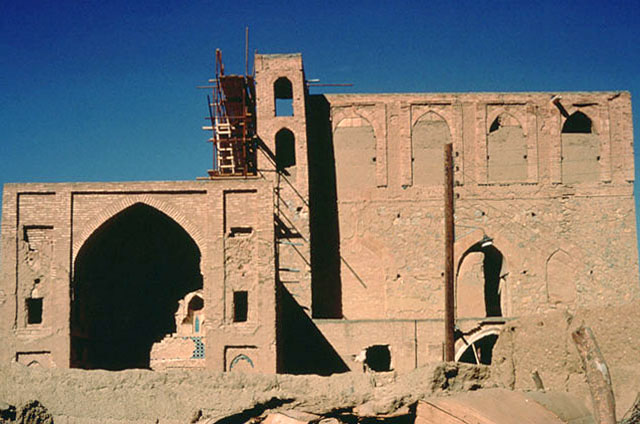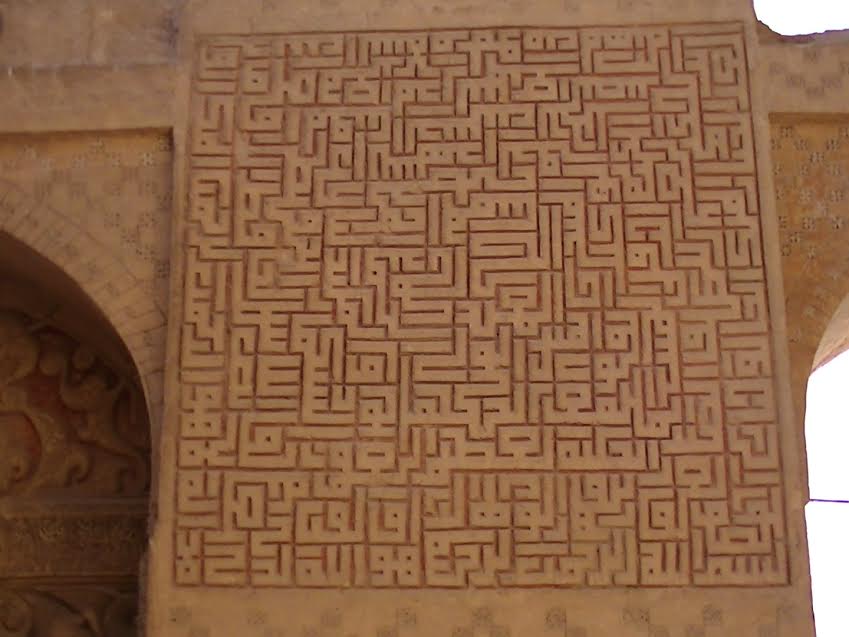After years running this blog, I realized I have not devoted even one single article to a Square Kufic inscription. Which sounds weird, considering the name of this blog. In any case, the time has come.
A reader, JJ (I don’t know the full name, thus, let’s call him/her JJ), sent me a couple of photos of the Square Kufic inscriptions of the Pir-i Bakran Shrine, in the Linjan district, Iran. And I was struck by the idea to write something about it.
THE MONUMENT
The Pir-i Bakran is a peculiar and important monument. It is a shrine, but originally it was not. First of all, the monument is dedicated to the Sheikh Bakran, a Sufi saint and mystic that died in 1303 CE. We must assume he was famous, but in fact, we do not know a lot about this Sufi teacher: no known hagiography contains any information about him and his life. From the local traditions and the historical inscriptions found in the shrine, scholars have inferred that Bakran should have lived and taught in the very same monument that later would have become his shrine. But this is not the only obscure feature of the monument.

The location of the building is also difficult to interpret. It is located on a sacred site: a Jewish cemetery that dates back to the 2nd century CE, the Esther Khatun. Also, a pre-existing tomb was located under a domed chamber, eventually incorporated into the existing monument. Another special feature of the shrine is the jutting rock that is in the interior, which is related to the prophet Elijah ascension.
The monument was thus pre-existent, at least partially, when the Sufi saint Bakran died in 1303 CE. And from then on, it is difficult to trace the path the construction of the monument followed, as Pope himself wrote in his Survey: “The building suffers from indecision and complexity of motive as well as the vicissitudes of its own history.”
In other words: understanding what happened and who built what, and when, is hardly possible.
But something that is remarkable in this building is the variety of decorative patterns and inscriptions, also Square Kufic inscriptions, that can be found: a sort of museum of Ilkhanid decorative motives. And as written in the Archnet page of the monument: “The Pir-i Bakran shrine is a significant instance of the building program begun at the turn of the fourteenth century with the conversion of the Il-Khanid Mongol ruler of Persia, Ghazan Khan (reg. 1295-1304), and which continued under his immediate successors, Uljaytu (reg. 1304-1316) and Abu Said (reg.1317-1335). Along with the shrines at Bistam and Natanz, the mausoleum of Pir-i Bakran epitomizes the sumptuous architectural patronage of the Il-Khanid rulers, as well as the development of Iranian architecture in the early fourteenth century.”

THE INSCRIPTIONS – TYPES
On the outside, the remains of the decoration do not bear any trace of inscriptions. The inscriptions are all inside the shrine. The Square Kufic inscriptions, even if written in the same script, are of different types, the main difference being how the text is arranged. In some of the inscriptions, the text is linear, following a line (simple, right?); in some others, the text is diagonal. This is the arrangement of the majority of Square Kufic inscriptions we have in mind, the ‘open’ ones, i.e. the ones that can go on and on and on, without an end. They are highly decorative and are composed of a base unit of inscription that is repeated over and over, placed diagonally (thence the name). This type of arrangement is common in patterns used to decorate walls.

The most interesting arrangement of the inscription, though, is the ‘spiral arrangement’. In this case, the inscription is closed (the text is clearly defined within a square panel) and the text starts in a corner (usually the bottom right corner) and goes all around the panel, completing its rotation in the center of the panel.
SPIRAL SQUARE KUFIC: TWO EXAMPLES
And now, let’s see two examples of Square Kufic panels with a spiral arrangement. They are both inscriptions that you might have already seen if you have ever looked for ‘square kufic’ on Google Images.

The inscription, in this case, starts on the bottom right corner and goes all around. The last word is near the center of the panel. It reads:
اللهم صل على محمد المصطفى وصل على علي المرتضى وصل على فاطمة الزهرا وصل على خديجة الكبرا [ى] وصل على حسن مجتبا وصل على حسين شهيد كربلا وصل على علي زين العابدين وصل على محمد باقر وصل على جعفر صادق وصل على[ و] موسى الكاظم وصل على علي موسى رضا وصل على محمد تقى وصل [على] علي نقي وصل على حسن العسكري وصل على محمد مهدي
That we can translate as follows:
Blessing of Allah on Muhammad al-Mustafa, ‘Ali al Murtada, Fatima al-Zahra, Khadijat al-Kubra, Hasan Mujtaba, Husayn Shahid Karbala, ‘Ali Zayn al-Abidin, Muhammad Baqir, Ja’far Sadiq, Musa al-Kazim, ‘Ali Musa Rida, Muhammad Taqi, ‘Ali Naqi, Hasan al-‘Askari, and Muhammad Mahdi.

A second panel, instead, contains some of the names of God:
بسم الله الرحمن الرحيم هر الله الذي لا اله إلا هو الرحمن الرحيم المك [الملك] القدوس السلاّم المؤمن المهيمن العزيز الجبّار المتك [المتكبر] الخالق الباري المصوّر الغفّار القهّاب الوهّاب الرزّاق الفتّاح العليم القابص الباسط الخافض الرافع المعز المذل السميع البصير الحكم العدل اللطيف الخبير الحليم العظيم الغفور الشكور [العلي الكبير] الحفيظ المقيت الحسيب الجليل الكريم الرقيب المجيب الواسع الحكيم الودود المجيد الباعث الشهيد الحق الوكيل القوي المتين الولي الحديم المحصي المبدي المعيد المحي المميت الحي
In the name of God, the Compassionate, the Merciful. God, there is no other but Him. He is the Compassionate, the Merciful, the Sovereign Lord, the Holy, the source of Peace,the Believer, the Vigilant, the Mighty, the Compeller, the Proud, the Creator, the Evolver, the Fashioner, the Pardoner,the Dominator, the Bestower, the Dispenser of all good, theVictorious, the All-Knowing, He who restrains, He whoexpands, He who humbles, He who raises dignity, He who gives honour, He who abases and degrades, the Hearer, the All-Seeing, the Judge, the Just, the Benevolent, theSagacious, the Gentle, the Inaccessible, the Indulgent Pardoner, the Very Grateful, the Vigilant Guardian, the Nourisher, the Determiner, the Majestic, the Generous, the possessive Guardian, the Assenter, the Omnipresent, the Wise,the Very Loving, the Glorious, the Revivifier, the Witness, theTruth, the Trustee, the Powerful, the Unshakable, the Friend, He who is worthy of All-Praise, the Numberer, the Innovator, He who resuscitates, the Creator of Life, the Creator of Death, the Living.

The inscription, once again, starts in the bottom right corner and continues clockwise.
Sources
This article is based on the info found on Archnet, the page of the Pir-i Bakran Shrine on kufic.info.
The most valuable source remains the second third chapter of the PhD thesis by Tehnyat Majeed, The phenomenon of the Square Kufic script: the cases of Ilkhanid Isfahan and Bahri Mamluk Cairo, University of Oxford 2006. [available online (last accessed: 29th April 2018)].